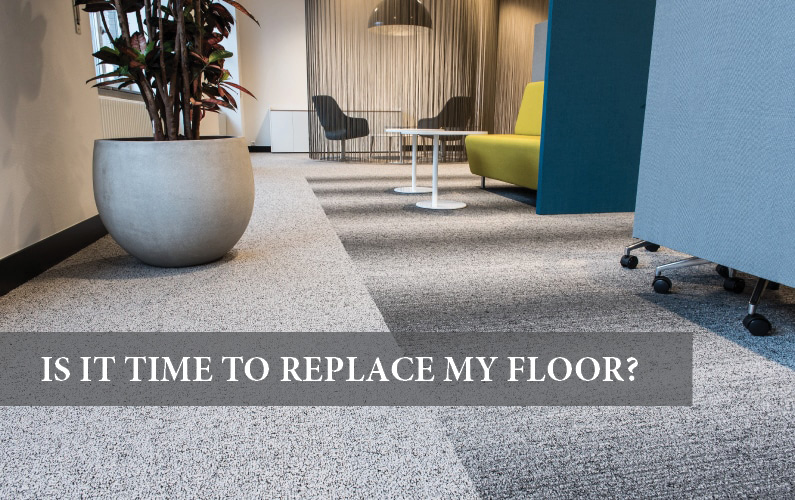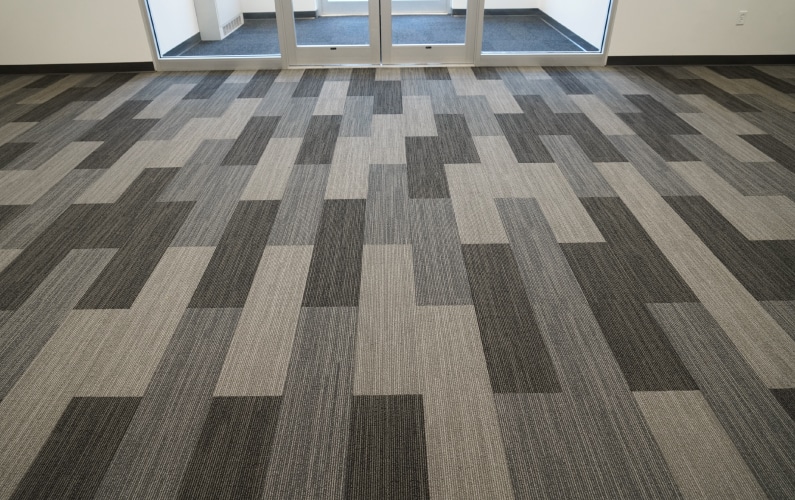When to replace commercial flooring — and tips for ensuring a successful project
A flooring replacement, at its simplest, is the chance for a fresh start for your facility. An updated look for a corporate office with a new open concept layout. A more durable solution for a commercial kitchen that will stand up to intense foot traffic and frequent spills. A streamlined maintenance program for a school campus that will save the district valuable time and money for years to come.
Deciding you’re ready for a commercial flooring replacement (and the aforementioned benefits) is the first step. Setting up this installation for success from start to finish — that’s what comes next.
In this article, we’ll answer key commercial flooring replacement questions like:
- When should I replace commercial flooring?
- Should I install the same material or something new?
- And what if I simply need to replace a portion of the flooring?
The answers to these questions, plus advice gleaned from thousands of installations, will help you achieve a smooth and successful replacement project.
When should I replace my floor?
Often, facility managers will know when the flooring system needs to be replaced. The signs of a necessary replacement can include:
- Visible wear and tear. Frayed carpet edges, scratches in the vinyl, dingy grout lines that won’t get clean — whatever it is, you know it looks worn and needs replacing.
- Safety issues. If there are tripping hazards or other damages that have put safety codes at risk (such as with this VA hospital, where loose and buckled tiles became a hazard for blind and vision impaired patients), you’ll need to look at updating the floor.
- Major damage from an unexpected event. It’s something you never want to deal with. But sustaining damage from a flood, fire or burst pipe can lead you to reevaluate your current flooring system.
- Scheduled end-of-life. Flooring systems can last a finite amount of time — sometimes 5 years, sometimes 25 — but if you’re approaching the end of that timeline, replacement can help you get ahead of wear or safety issues.

Or perhaps the decision is less performance-driven and more about an aesthetic refresh, such as updating your look for a new tenant, a new layout (and the need to resurface where old walls were) or a more on-trend design.
Additionally, there are a few indicators that aren’t immediately noticeable to the untrained eye. These can signify that you need to replace the flooring system, or perform additional work alongside your replacement (typically related to the slab).
Commercial flooring contractors know to look out for these signs — and now you can, too:
Flooring adhesive seeping through the seams
This can indicate there is moisture in your slab. Because most flooring adhesives are water-based, they react negatively when they come in contact with water vapor and moisture content (i.e., water that comes up through the slab). It will re-emulsify and become wet and puddled under the floor — causing a failure in the adhesive and the flooring system itself. In these scenarios, it’s possible that moisture remediation will need to accompany your flooring replacement.
Waviness or high/low spots on a floor that should be even
These small inaccuracies can point to substrate deficiencies, perhaps from a previous installation that wasn’t completed to a high standard. You may not need to immediately replace flooring if you spot this, but you probably want to include slab work in tandem with your next replacement.
Depending on the nature of the dips, your flooring partner will use a self-leveling concrete for larger dips, a feather edge patch for smoothing smaller inconsistencies or a combination. This will create a flat and consistent substrate for an evenly finished flooring product.
Cracks in grout lines
Spotting these in your porcelain, ceramic or natural stone tile floor can point to slab movement. These materials (and their cementitious layer below) by nature are not flexible like carpet tile or vinyl, so cracks in the slab eventually crack the tile, creating an eyesore and a safety hazard.
To remedy this issue, your flooring contractor may need to add crack isolation membranes prior to installing the new tile. These can come in different forms (primer, uncoupling membranes) and will allow some movement (some up to a ¼ inch) in the slab — without compromising the tile.
The beginnings of mold growth
Look out especially in food service areas, bathrooms and hospital rooms with showers. This can occur if the original installer failed to apply the proper waterproofing membrane and sealants, so you’ll want to address it correctly this time around.
Should I re-install the same material — or change flooring systems?
There is a short answer and a long answer to this commercial flooring replacement query.
Short answer? Follow the old adage: If it ain’t broke, don’t fix it. If your current flooring system has been durable enough for your environment, requires a doable amount of maintenance and looks good in your facility, then there is nothing wrong with re-installing the same material or something pretty much replicating what was there before.
But, there is another way to look at it.
Long answer? If you’re going through the entire process of a flooring replacement, why go back with the same old thing?

Consider the potential benefits for re-evaluating your flooring system and ending up with solution that better serves your facility’s needs:
More durable flooring — and improved facility image
It may be as simple as noting that the fading on the carpet from traffic patterns looks unattractive, so you switch to a harder surface such has ceramic tile or LVT that won’t show wear as easily. Or, for example, one high-rise apartment building manager for luxury residences faced constant patches and repairs — and constant complaints from the discerning tenants.
The investment in a more durable flooring can make a lifetime of difference in how your facility is perceived and how quickly it shows signs of wear.
Read more here about durable flooring options.
Less intensive maintenance — and a freed-up budget
The most illustrative example of this will be on school campuses: If decision-makers chose to go back with the same VCT they’ve had for the last few decades, they’ll continue to spend on time, labor and equipment for annual or semi-annual floor waxing maintenance.
But if they consider a material like LVT or a vinyl with notably less maintenance, the lifetime savings on maintenance could be significant (in addition to an updated look that breaks away from the standard institutional look).
Read more here about low maintenance flooring options.
New flooring, fresh outlook
Trends change — and keeping your flooring up-to-date with the current look can help your facility maintain a feeling of freshness and attractiveness. Polished concrete is installed in modern office spaces, solid hardwood (and its signature character) is coming back around in commercial spaces — the options for a new material and an accompanying new look are limitless.
All in all, there are plenty of opportunities for flooring improvements and their subsequent benefits. If you do choose to consider a new material, always make sure to ask the standard gatekeeping questions (What function must this flooring serve? What are the maintenance requirements? How much budget do I have?) to ensure you land on a new look that meets all your performance demands.
Advice for partial flooring replacements
Sometimes a complete flooring overhaul isn’t necessary. Perhaps you’re conducting a room turn for a multi-family apartment complex, overseeing a small repair in a patient room at a medical facility or updating a handful of offices for a longstanding corporate tenant.
In these smaller replacements, dipping into your attic stock (i.e., extra material of the original flooring — we’ll discuss it more in the next section) is a straightforward solution.
If you don’t have any (or enough) attic stock, you have a few options. You could try to order more of the same product or something similar, but we find this can cause some glitches. Depending on how long ago you ordered the material, it may not be manufactured any more or the “same” item may now look slightly different due to changing production methods, dye lots and so on.
Instead, we recommend finding the same material in a corresponding or even contrasting color/pattern to make the change look more intentional.

The importance of attic stock
Attic stock is a key resource to have on hand when you need to do a partial replacement (like we discussed above) or repair just a small section due to spillage or damage.
You may be thinking, “Why can’t I just order more of the material when and if I need it?” That sounds great in theory, but doesn’t always work out in practice.
Like we mentioned above, the product may not be in stock or manufactured to achieve the same end look. And that’s assuming you have on-file the original flooring plans, the exact order specifications and so on. Retracing your LVT ordering steps three or four years later is cumbersome — and you might not even end up finding the exact same product.
Instead, whenever you install a new flooring system, order 2-3% extra material and label it properly so it’s easy to sort through when it comes time to replace. You may order more depending on the size and foot traffic in your facility; on corporate projects with 30,000 yards of carpet, facility managers will order as much as 10% surplus for their attic stock to have on-hand for inevitable spill and wear.
This is of course an additional budget line item. But this small investment can keep quick replacements painless, saving valuable time for you and your team. And most importantly, this resource can prevent you from having to make the choice between an unsightly section of mismatched flooring or an unexpected entire replacement when localized flooring damage occurs.
Feel prepared for your upcoming flooring replacement?
Undertaking a remodeling project like this requires foresight and preparedness. You’ve already taken the first step in gathering general advice and considerations.
The next step is to talk specifics of your projects so you can get specific advice — and our flooring experts are just the resource.
At Spectra, we’ve overseen flooring replacements across 400,000 projects and counting and know how to make these jobs run smoothly. We’ll learn about your current flooring system, make sure the new material fits your needs and ensure a smooth installation from start to finish. Start a conversation today.

What to look for when evaluating flooring bids — and what to avoid
Incomplete flooring bids with a flashy number at the bottom may be tempting, but can lead to frequent change orders and over-budget projects. Learn how to evaluate bids and set projects up for success.
